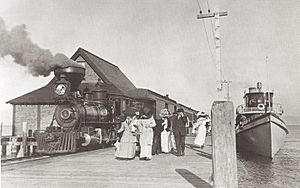SS Tahoe facts for kids

Tahoe circa 1906
|
|
| History | |
|---|---|
| Owner | Duane Leroy Bliss |
| Builder | Union Iron Works |
| Yard number | 42 |
| Launched | 24 June 1896 |
| Fate | Scuttled 1940 |
| General characteristics | |
| Type | Steamship |
| Displacement | 154 tons |
| Length | 169 ft 9 in (51.74 m) |
| Beam | 17 ft 10 in (5.44 m) |
| Draft | 6 ft (1.8 m) |
| Depth | 9 ft 10+1⁄2 in (3.010 m) |
| Installed power | 2 × triple expansion steam engines 1,200 hp (890 kW) total |
| Propulsion | Twin 4 ft 10 in (1.47 m) screws |
| Speed | 18+1⁄2 knots (34.3 km/h; 21.3 mph) |
| Capacity | 200 passengers |
|
SS Tahoe
|
|
| Location | Lake Tahoe |
| Nearest city | Glenbrook, Nevada |
| NRHP reference No. | 04000026 |
| Added to NRHP | February 11, 2004 |
The SS Tahoe was a famous steamship that sailed on Lake Tahoe for many years. It was built in the late 1800s and used until the mid-1900s. In 1940, the ship was intentionally sunk, or "scuttled," and now rests about 400 feet (120 m) deep in the water near Glenbrook, Nevada.
In 2002, a special team called New Millennium Dive Expeditions (NMDE) explored the wreck. This was a record-setting dive because of how high up Lake Tahoe is. Because of their work, the Tahoe became the first underwater historical site in Nevada to be listed on the National Register of Historic Places. This list helps protect important places in the United States.
Contents
A Famous Lake Tahoe Ship
By the end of the 1800s, Lake Tahoe was a popular vacation spot. Many hotels and small towns were built around the lake. Steamships like the Tahoe helped people travel between these places.
Building and Launching
A man named Duane Leroy Bliss, who was a very successful lumber businessman, ordered the Tahoe in 1894. It was built by a company called Union Iron Works in San Francisco. The ship was taken apart and shipped by train to Carson City. From there, it was moved by wagons to Glenbrook, where it was put back together. The Tahoe was launched on June 24, 1896, with a big celebration.
Life on the Lake
The Tahoe was the largest steamship on the lake, measuring 169 feet (52 m) long. It had two powerful engines that ran on wood, making a total of 1,200 hp (890 kW). These engines powered two propellers, helping the ship move quickly.
The ship could carry 200 passengers and was very fancy inside. It had comfortable leather seats, soft carpets, and even marble sinks in the bathrooms. It also had modern features for its time, like electric lights, bells, hot and cold running water, and steam heating to keep passengers warm.
From 1901, the Tahoe would leave from a pier in Tahoe City every morning during the summer. It would travel around the lake, stopping at different communities, and return in the late afternoon. Besides carrying passengers, it also transported goods and mail.
Its Final Resting Place
In 1934 and 1935, a new road was built all the way around Lake Tahoe, making it easy for cars to travel. Also, in 1934, the Tahoe lost its contract to carry mail to another ship. Because of these changes, it became too expensive to operate the Tahoe, and it was not used for several years.
In 1940, Duane Leroy Bliss's son, William Seth Bliss, bought the ship back. He wanted to sink it in shallow water near Glenbrook as a memorial. He hoped people could see it from glass-bottomed boats. The Tahoe was scuttled on August 29, 1940. However, the underwater ground was much steeper than expected. The ship slid down deeper than planned, with its front end resting at 360 feet (110 m) and its back end at 490 feet (150 m).
Exploring the Wreck
In 2002, the non-profit group New Millennium Dive Expeditions from Reno made history by reaching the Tahoe wreck. This was a very challenging high-altitude scuba diving feat. The information they collected about the wreck was very important. It helped the Tahoe be officially listed on the National Register of Historic Places. The NMDE team continued their work in 2009 and 2010, visiting the wreck again to learn more.
In July 2016, an underwater drone, which is like a remote-controlled robot, filmed the Tahoe wreck. This was part of a project to create affordable underwater exploration devices.

